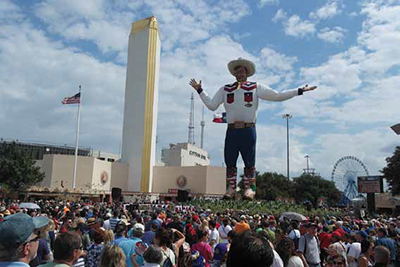A new and improved Big Tex welcomed guests to the 2013 State Fair of Texas thanks to SRO Associates and Texas Scenic.
After the original Big Tex was destroyed by fire in 2012, he was rebuilt bigger and better than ever, tipping the scales at 25,000 pounds and towering over the fairgrounds at 55 feet tall. The iconic giant cowboy had been greeting fairgoers since 1952 when it was destroyed by fire near the end of 2012’s State Fair. The rebuilt Big Tex is bigger and better than ever, tipping the scales at 25,000 pounds and towering over the fairgrounds at 55 feet tall. He boasts a new red, white, and blue outfit, and boots decorated with the Texas and American flags, the State Capitol, bluebonnets, longhorns, and other Lone Star State imagery.
Big Tex was not a static figure. He waved his hand, turned his head, and spoke, pointing guests to The Million Dollar Midway and the Texas-sized fun and wonders that awaited them. Over a period of 10 months, SRO Associates designed and built the shape and visible parts of Big Tex at its studios in Boerne, TX and partnered with Texas Scenic in San Antonio to engineer the structure and design the mechanisms that make the giant cowboy come to life.
Key to making Big Tex bigger and better was developing a new control system, said Louis Bohn, lighting designer and technology project manager at SRO Associates. “Before, the control was hydraulic. There was a button panel like you might see on any fairground ride,” he explained. “But they wanted to add more movement to Big Tex and make those movements more fluid, so we elected to go with large industrial electric motors and a new user interface.”
Bohn had worked with Alcorn McBride on a previous project and turned to the manufacturer for its V4 Pro frame-accurate controller and AM4 Digital Audio Machine, which “really filled the bill” for Big Tex’s audio needs. “We needed a scheduler and interface to drive the motors, a very robust system that would run 24/7 and a system that allowed some audio mixing. That’s how I wound up with Alcorn McBride.”
Big Tex’s moving mouth had to function with the live voice of the giant cowboy as well as with prerecorded audio. “With the prerecorded audio we originally planned to do a timeline of mouth movements to audio. When we decided to actually interface with audio we had to come up with a system to make it more dynamic,” said Bohn.
With five motors inside the head of Big Tex, SRO devised the idea of using a light organ device to take the incoming audio signal and split it into low-, mid-, and high-frequency signals and give them a visual orientation. “We were able to convert that to numbers and go into the V4 Pro controller and apply numbers directly into SEW Eurodrive’s MOVI-PLC (Programmable Logic Controller), which controlled the motors,” Bohn explained. “We added an audio delay to compensate for the latency of communication, and everything worked fantastically well.”
He noted that “there was no textbook to reference” for solving the audio needs of the giant cowboy, so ingenuity and innovation were essential to deliver his much enhanced audio capabilities. With the solution SRO developed, “we could analyze the audio and move his mouth accordingly,” Bohn said. “Based on amplitude, his mouth not only moved at the right time, but also differently depending upon the audio. Big Tex opened his mouth more and gestured more depending upon the live or prerecorded audio. That way we didn’t have to preprogram the mouth movements for the prerecorded audio, which wouldn’t look the same—or as good—as the live audio.”
Alcorn McBride engineer Joy Burke explained that the V4 Pro starts and stops Big Tex’s performance via the Showtouch software interface via touch panel. The V4 Pro “easily interfaced with the complex systems involved in this show and communicated with the MOVI-PLC as well as the AM4 audio player,” she noted.
Specifically, the V4 Pro sends the MOVI-PLC “appropriate commands and toggle bits to allow it to follow the audio file and tell the PLC when to move Big Tex’s mouth up and down,” Burke elaborated. The V4 Pro triggers prerecorded audio tracks with a timeline and audio tailored to particular times of day by reading the audio values and sending commands as needed. For live audio, when the voice of Big Tex uses the microphone, the V4 Pro makes the figure’s mouth movements coincide.
Bohn said he approached programming Big Tex as a lighting designer, making “individual modules to pull into different sequences. Any single movement required at least 12 bits of data. Big Tex had 80 prerecorded messages, and I didn’t want to do all that programming 80 different times. So the operator simply pressed a single button on the computer to get the whole thing started.”
He reported that Big Tex’s audio “worked really well” and gives kudos to Burke for being “instrumental in helping us line up all these systems. We all worked together to integrate everything, and Alcorn McBride updated firmware to tailor the system for us. Alcorn and Joy were phenomenal and very supportive of the project.”
Bohn believes Big Tex may be improved even further by the next State Fair. “We may add new movements other than his mouth, head and hand. We’d like to be able to have his forearm move for a much more natural wave. That will be a big upgrade.”










